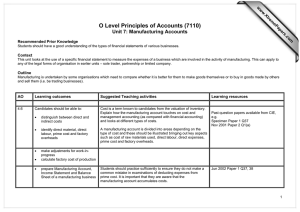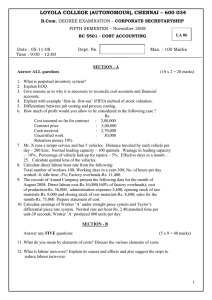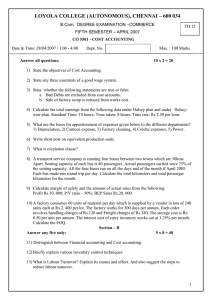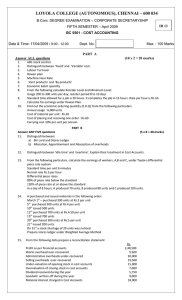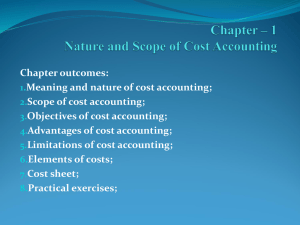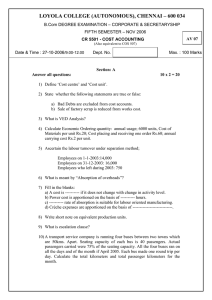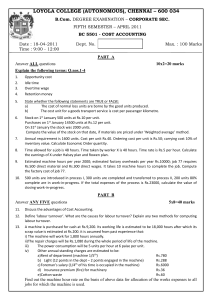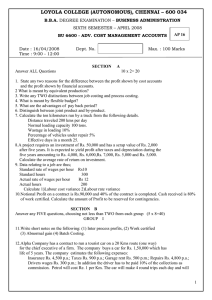LOYOLA COLLEGE (AUTONOMOUS), CHENNAI – 600 034
advertisement
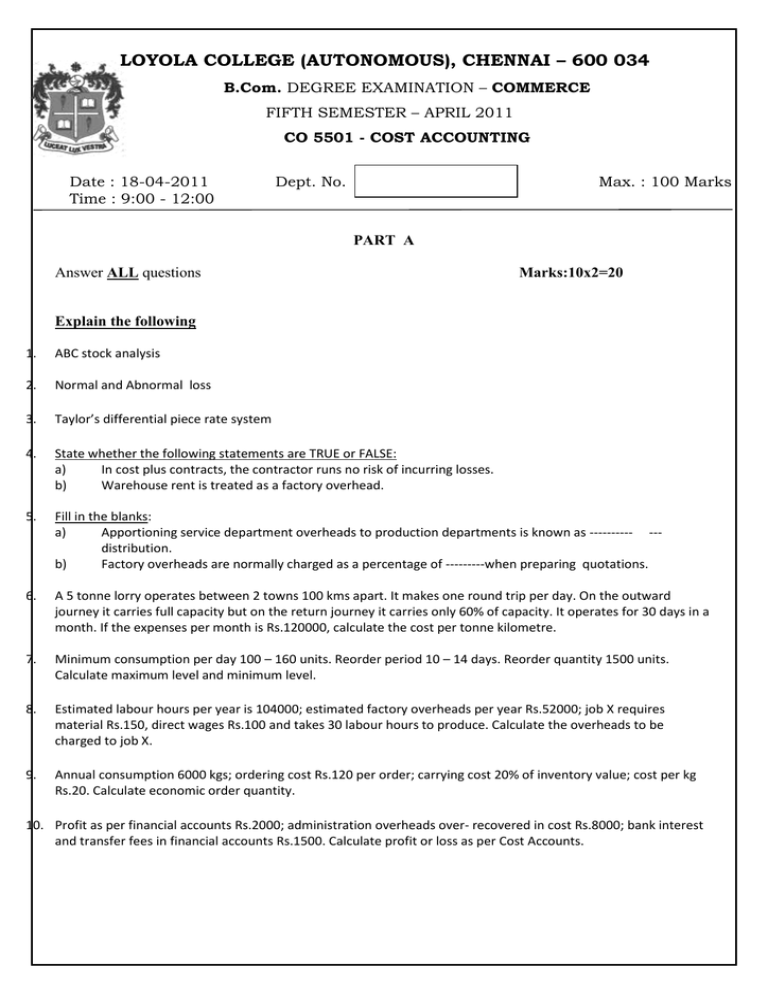
LOYOLA COLLEGE (AUTONOMOUS), CHENNAI – 600 034 B.Com. DEGREE EXAMINATION – COMMERCE FIFTH SEMESTER – APRIL 2011 CO 5501 - COST ACCOUNTING Date : 18-04-2011 Time : 9:00 - 12:00 Dept. No. Max. : 100 Marks PART A Answer ALL questions Marks:10x2=20 Explain the following 1. ABC stock analysis 2. Normal and Abnormal loss 3. Taylor’s differential piece rate system 4. State whether the following statements are TRUE or FALSE: a) In cost plus contracts, the contractor runs no risk of incurring losses. b) Warehouse rent is treated as a factory overhead. 5. Fill in the blanks: a) Apportioning service department overheads to production departments is known as ---------- --distribution. b) Factory overheads are normally charged as a percentage of ---------when preparing quotations. 6. A 5 tonne lorry operates between 2 towns 100 kms apart. It makes one round trip per day. On the outward journey it carries full capacity but on the return journey it carries only 60% of capacity. It operates for 30 days in a month. If the expenses per month is Rs.120000, calculate the cost per tonne kilometre. 7. Minimum consumption per day 100 – 160 units. Reorder period 10 – 14 days. Reorder quantity 1500 units. Calculate maximum level and minimum level. 8. Estimated labour hours per year is 104000; estimated factory overheads per year Rs.52000; job X requires material Rs.150, direct wages Rs.100 and takes 30 labour hours to produce. Calculate the overheads to be charged to job X. 9. Annual consumption 6000 kgs; ordering cost Rs.120 per order; carrying cost 20% of inventory value; cost per kg Rs.20. Calculate economic order quantity. 10. Profit as per financial accounts Rs.2000; administration overheads over- recovered in cost Rs.8000; bank interest and transfer fees in financial accounts Rs.1500. Calculate profit or loss as per Cost Accounts. PART B Answer ANY FIVE questions Marks:5x8=40 11. State the reasons why the profit as per cost account and financial accounts differ. 12. Explain the following terms in the context of a Contract Account: a) works certified (b) work uncertified (c) retention money (d) escalation clause. 13. The following particulars relate to the production department of a factory for the month of June, 2010: (Rs.) Materials used 80,000 Direct wages 72,000 Direct labour hours worked 20,000 Hours of machine operation 25,000 Overhead charges allocated to the department 90,000 Cost data of a particular work order carried out in the above department during June, 2010 are given below: (Rs.) Material used 8,000 Labour hours booked 3,300 Direct wages 6,250 Machine hours booked 2,400 What would be the factory cost of the work order under the following methods of charging overheads: (i) Direct labour cost rate; (ii) Machine hour rate; and (iii) Direct labour hour rate. 14. From the following data compute the cost per running kilometer: Items Vehicle A Kilometers run (annual) 15,000 Cost of vehicles Rs.25,000 Road licence (annual) Rs. 750 Insurance (annual) Rs. 700 Garage rent (annual) Rs. 600 Supervision and salaries (annual) Rs. 1,200 Driver’s wage per hour Rs. 3 Cost of fuel per gallon Rs. 3 Kilometers run per gallon (kms) 20 Repairs and maintenance per km (Rs.) 1.65 Tyre allocation per km (Rs) 0.80 Estimated life of vehicles (kms) 1,00,000 Charge interest at 5% on cost of vehicle. The vehicle runs 20 kms per hour on an average. 15. M/s Indu Industries Ltd., are the manufacturers of moon-light torches. The following data relate to manufacture of torches during the month of March 2011: Raw materials consumed Rs.20,000 Direct wages Rs.12,000 Machine-hour worked 9,500 hours Machine-hour rate Rs.2 Office overheads 20% of works cost Selling overheads Rs.0.50 per unit Units produced 20,000 Units sold 18,000 @ Rs.5 per unit Prepare Cost Sheet showing the cost and the profit per unit and the total profit earned. 16. The following are the details supplied by AB Ltd., in respect of its raw materials for the month of November 1990. Date 01.11.2010 Opening balance 1,000 units @ Rs.6 per unit 10.11.2010 Received 500 units at Rs.7 per unit 15.11.2010 Issued 1200 units 20.11.2010 Received 1,000 units at Rs.8 per unit 30.11.2010 Issued 1,100 units 0n 30th November a shortage of 50 units was found. Prepare the Stores Ledger under, Weighted Average method. 17. A, B and C on a particular day produced 200, 250 and 300 pieces respectively of a Product ‘P’. The time allowed for production of 25 units of ‘P’ is 1 hour and the hourly rate of wage payment is Rs.8. Calculate for each of the three workers their earnings for a day (8 Hours per day), and the Effective Rate of Earnings per hour under Halsey Premium Bonus Plan and Rowan Premium Bonus Plan. 18. The following data relate to process 1. Opening Work in progress 900 units valued at Rs.4500 (material 100%, labour and overheads 60%) Input of materials 9100 units at Rs.27300. Direct wages Rs.8200 Production overheads Rs.16400 Units scraped 1200 (material 100%, labour and overheads 70%) Closing work in progress 1000 units (material 100%, labour and overheads 80%) Units transferred to Process 2 - 7800 Normal process loss 10% of total input Scrap value Rs.3 per unit Compute equivalent production and cost per equivalent unit of each element and the value of the closing Work in Progress. PART C Answer ANY TWO questions 19. Marks:2x20=40 The Profit and Loss Account of Oil India (Pvt) Ltd., for the year ended 31st March, 2011 is as follows: Materials Wages Direct expenses Gross profit (Rs) 4,80,000 3,60,000 2,40,000 1,20,000 Sales Closing stock Work in progress: Materials 30,000 Wages 18,000 Direct expenses 12,000 12,00,000 Administration expenses Income tax Net Profit 60,000 10,000 58,000 1,28,000 Gross Profit Interest received (Rs) 9,60,000 1,80,000 60,000 12,00,000 1,20,000 8,000 1,28,000 As per the cost records, the direct expenses have been estimated at a cost of Rs.30 per kg and administration expenses at Rs.15 per kg. During the year 6000 kgs were manufactured and 4800 kgs were sold. Prepare a statement of costing profit and loss account and reconcile the profit with financial records. 20. A product is finally obtained after it passes through three distinct processes. The following information is available from the cost records. Process I Process II Process III Total Rs. Rs. Rs. Rs. Materials 2,600 2,000 1,025 5,625 Direct wages 2,250 3,680 1,400 7,330 Production overheads 7,330 500 units @ Rs.4 per unit were introduced in Process I. Production overheads are absorbed as a percentage of direct wages. The actual output and normal loss of the respective processes are given below: Output Normal loss as a Value of scrap (units) %age of input (per unit) Process I 450 10% Rs.2 Process II 340 20% Rs.4 Process III 270 25% Rs.5 Prepare the process accounts, Normal loss account, Abnormal loss accounts and Abnormal Gain account. 21. M/s Contractor and Engineer undertook a contract for Rs.2,50,000 for constructing a college building. The following is the information concerning the contract during the year 2010: (Rs.) Materials sent to site 85,349 Labour engaged on site 74,375 Plant installed at site at cost 15,000 Direct expenditure 3,167 Establishment charges 4,126 Materials returned to store 549 Work certified 1,95,000 Cost of work not certified 4,500 Materials at site on 31.12.2010 1,883 Wages accrued on 31.12.2010 2,400 Direct expenditure accrued on 31.12.2010 240 Value of plant on 31.12.2010 11,000 Cash received from contractee 1,80,000 Prepare the Contract Account, the Contractee’s Account and show how the work-in-progress will appear in the Balance Sheet of M/s. Contractor and Engineer as on 31st December, 2010. ****** $$$$$$$
